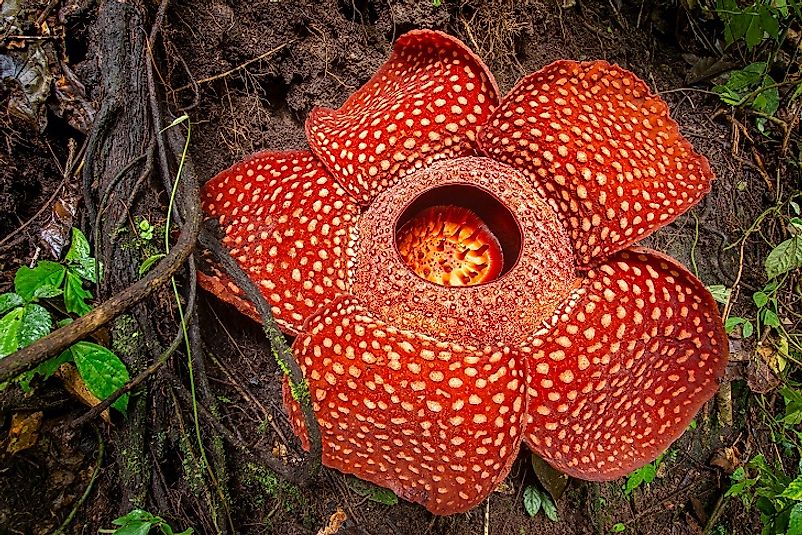
Source : worldatlas
Rafflesia is a genus of flowering plant consisting of twenty-eight species. For example, Rafflesia keithii, Rafflesia kerrii, Rafflesia arnoldii, Rafflesia hassetii, Rafflesia manillana etc. The most remarkable species is Rafflesia arnoldii which is the world’s largest single blooming flower. It has a diameter of three feet (0.914 metre) and can weigh between 15 to 24 pounds (6.8 to 10.8 kilograms).
Habitat:
This rare monster flower is found only in South East Asia. It grows on the tendrils of the Tetrastigma vine which grows in the tropical rainforest of Malaysia, Indonesia, Sumatra, Java, Philippines, Borneo and Thailand. The rainforest is continuously humid and warm in these tropical rainforests. At night the humidity is often 100%.
Emblem:
Rafflesia arnoldii is one of the floral emblems of Indonesia. It represents the floral biodiversity and uniqueness. In Indonesian language it is called “Padma raksasa”.
Nomenclature:
In 1818 the British governor of Bencoolen currently known as Sumatra was very interested in the diversity of plant life on the island. Sir Thomas Stamford Raffles and Dr. Joseph Arnold made many expeditions into the jungle and discovered this previously unknown plant. Hence it was named Rafflesia arnoldii (using the last name of the two explorers).
Scientific Classification:
Domain: Eukaryota
Kingdom: Plantae
Phylum: Anthophyta
Subphylum: Magnoliophyta
Class: Magnoliopsida
Order: Rafflesiales
Family: Rafflesiaceae
Genus: Rafflesia
Species: Rafflesia arnoldii
Appearance:
Rafflesia arnoldii is a leather/rubber textured, reddish brown flower freckled with white spots. It has five plump petals with a bowl like centre having an underneath disk. The styles (female parts) or anthers(male parts) are situated underneath the disk. The pistils and stamens are combined together in a central column. The strange thing about this parasitic plant is that it has no visible roots, stem, leaves or photosynthetic tissues i.e. it has no chlorophyll. It is a vascular, parasitic plant. It embeds strands of tissue into its host -Tetrastigma vine and derives its nutrition and water from the host plant.
Reproduction and Pollination:
When Rafflesia is in full bloom it emits a repulsive putrid odour of rotten meat. This odour is nature’s method of attracting insects to pollinate the plant. Carrion flies is the most common pollinator of Rafflesia arnoldii. Pollination tends to be difficult mainly for two reasons. Firstly, these flowers are unisexual i.e. either male or female. The pollinators need to visit both male and female flowers which are not always in close proximity to each other. Secondly, the flower stays in bloom for a very short period of time – five to seven days. Hence there is a very narrow window of opportunity for pollination. Most of the time this rare floral species remains unobserved inside the roots and woody stems of its host plant. During its reproductive stage a plump cabbage like maroon or magenta coloured bud (about 12 inch or 30-centimetre-wide) forms outside the stem or root of its host plant and takes about nine months to bloom from its seed to pod to flower. The fruits are smooth skinned round berries about 5 inch in diameter filled with smooth flesh and thousands of hard coated minute seeds. Birds and squirrels love to eat this fruit and hence help in the seed dispersal.
Ecotourism:
Many sites where Rafflesia arnoldii grows have become popular tourist destinations. As a result of this human disturbance the number of buds blooming per year has decreased to a great extent at many sites.
Threat and Conservation:
Rafflesia arnoldii is becoming an endangered species. One of the main reason is deforestation for commercial logging(both illegal and legal), for growing the plantation crops like rubber and oil palm, for constructing highways, dams etc. Another common reason is ethnobotanical collection (Ethnobotany is the scientific study of a region’s plants and how local people use the native plants for medicinal, cultural, religious or other purpose). Efforts are being made to conserve this amazing species. Unfortunately, inspite of great efforts biologists have become unsuccessful in growing this flower by artificial methods. Hence the only method to conserve this species is to preserve its natural habitat.
Uses:
Rafflesia arnoldii buds are used as an aphrodisiac in traditional medicine. The traditional healers, bomohs and sinsehs boil these buds in water for few minutes, strain and then give the decoction to the pregnant ladies. The decoction promotes smooth delivery and easy recovery during and after childbirth. It stops bleeding and helps in regaining energy and strength. However, since rafflesia has a high concentration of phenols and tannins excessive use of the decoction proves harmful.
By Sumita Bose


